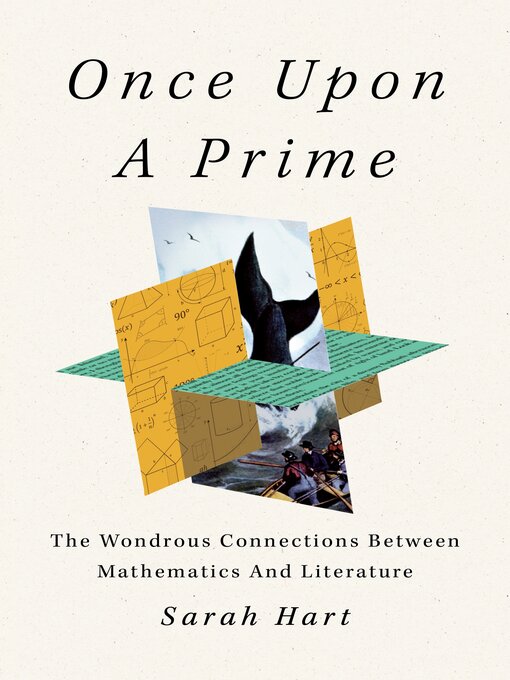A New York Times Book Review Editors' Choice
"Wide-ranging and thoroughly winning." —Jordan Ellenberg, The New York Times Book Review
"An absolute joy to read!" —Steven Levitt, New York Times bestselling author of Freakonomics
For fans of Seven Brief Lessons in Physics, an exploration of the many ways mathematics can transform our understanding of literature and vice versa, by the first woman to hold England's oldest mathematical chair.
We often think of mathematics and literature as polar opposites. But what if, instead, they were fundamentally linked? In her clear, insightful, laugh-out-loud funny debut, Once Upon a Prime, Professor Sarah Hart shows us the myriad connections between math and literature, and how understanding those connections can enhance our enjoyment of both.
Did you know, for instance, that Moby-Dick is full of sophisticated geometry? That James Joyce's stream-of-consciousness novels are deliberately checkered with mathematical references? That George Eliot was obsessed with statistics? That Jurassic Park is undergirded by fractal patterns? That Sir Arthur Conan Doyle and Chimamanda Ngozi Adichie wrote mathematician characters? From sonnets to fairytales to experimental French literature, Professor Hart shows how math and literature are complementary parts of the same quest, to understand human life and our place in the universe.
As the first woman to hold England's oldest mathematical chair, Professor Hart is the ideal tour guide, taking us on an unforgettable journey through the books we thought we knew, revealing new layers of beauty and wonder. As she promises, you're going to need a bigger bookcase.
-
Creators
-
Publisher
-
Release date
April 11, 2023 -
Formats
-
Kindle Book
-
OverDrive Read
- ISBN: 9781250850898
-
EPUB ebook
- ISBN: 9781250850898
- File size: 10399 KB
-
-
Languages
- English
-
Reviews
-
Kirkus
February 15, 2023
A mathematician looks at fiction and poetry and discovers a great deal that excites her. Hart opens by pointing out that Moby-Dick, Gulliver's Travels, and Tristram Shandy all contain references to cycloids, a "beautiful mathematical curve." Furthermore, Tolstoy writes about calculus, James Joyce about geometry. "Mathematical references in literary works," writes Hart, "go back at least as far as Aristophanes' The Birds, first performed in 414 BCE." The author makes an entertaining case for the importance of math in literature, but literature lovers may or may not share her fascination. Genuine insights appear throughout along with a great deal of information that would be classified as oddball. Readers will be amused if not enlightened to learn about Georges Perec's 1969 novel, La Disparition, in which the most common vowel, E, was absent. In the sequel, Perec used E but no other vowel. It's unclear how many readers will share Hart's wonder at books whose pages are scrambled or the chapters readable in any order. Much of her text is not concerned with mathematics but numerology, the popular if often mystical fascination with numbers and letters, but readers may perk up at her engrossing analysis of the significance of certain numbers in various cultures--e.g., "the nine realms of Norse mythology, the Five Pillars of Islam, and biblical references like seven deadly sins, the twelve apostles, the twelve tribes of Israel, the forty days and nights of Noah's flood, [and] the seventh seal." Hart detours into intriguing areas that require close attention, including fractals and cryptography. Halfway through, she returns to the classics, especially Melville, Tolstoy, Joyce, and Poe, with an entire chapter devoted to Swift and nearly as much to the only genuine mathematician among them, Lewis Carroll. Mathematics turns up here and there, but numerology continues to figure prominently, and Hart casts a critical eye on writers' calculations and science, both of which are often incorrect. Scattershot but often ingenious.COPYRIGHT(2023) Kirkus Reviews, ALL RIGHTS RESERVED.
-
Publisher's Weekly
February 20, 2023
This spirited if inessential debut by Hart, a math professor at the University of London, surveys how math influences the structure, symbolism, and themes of literature. She posits that math and literature are linked in their common “quest” to “understand human life and our place in the universe,” and analyzes how Chimamanda Ngozi Adichie, Kurt Vonnegut, and Oscar Wilde, among others, make use of mathematical concepts in their work. She explores in Moby-Dick the calculations behind Ishmael’s observation that a soapstone released along the interior of a vat for rendering whale oil will take the same time to slide to the bottom regardless of the height it’s released from. However, it’s not clear how this relates to Hart’s contention that the use of math by Melville’s characters signifies vain efforts to control and “navigate the unknowable universe.” Elsewhere, she notes that the patterns and rhythms of poetry are rooted in math, suggesting that the prime numbers in the haiku format (three lines of five and seven syllables) make the lines “separate indivisible entities.” Such connections come across as amusing trivia, but Hart fares better when examining authors who deliberately looked to math for inspiration, such as the French experimentalists known as the Oulipo who in the 1960s sought to devise original literary forms from mathematical ideas. This won’t change how readers see their favorite books, but there are some entertaining tidbits.
-
Formats
- Kindle Book
- OverDrive Read
- EPUB ebook
subjects
Languages
- English
Loading
Why is availability limited?
×Availability can change throughout the month based on the library's budget. You can still place a hold on the title, and your hold will be automatically filled as soon as the title is available again.
The Kindle Book format for this title is not supported on:
×Read-along ebook
×The OverDrive Read format of this ebook has professional narration that plays while you read in your browser. Learn more here.


